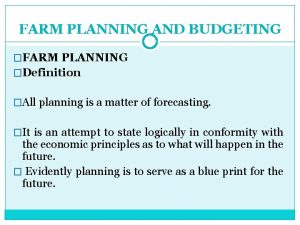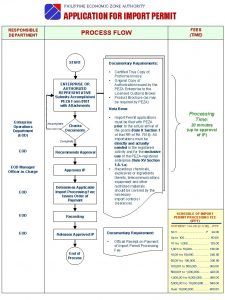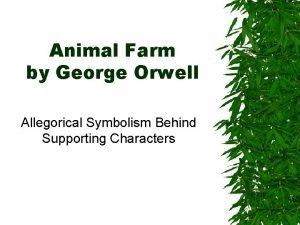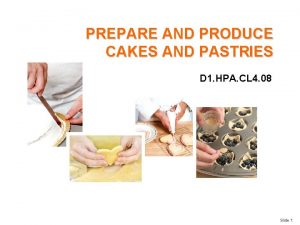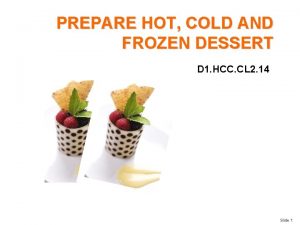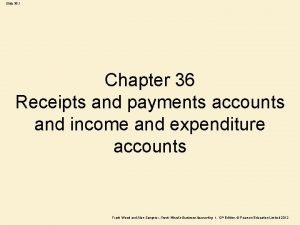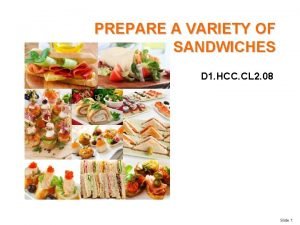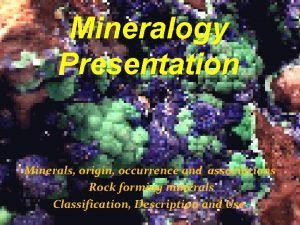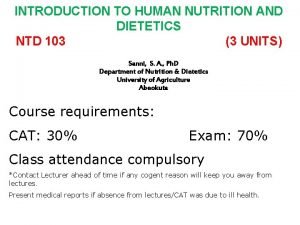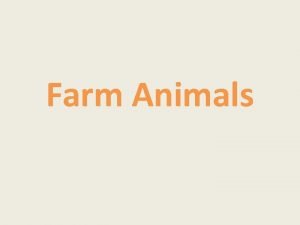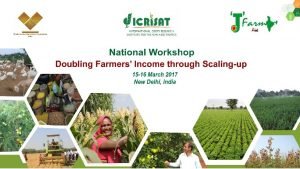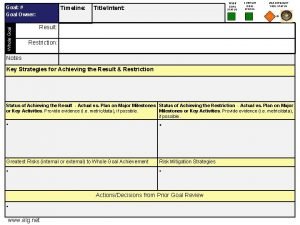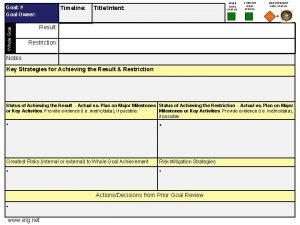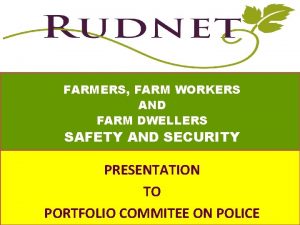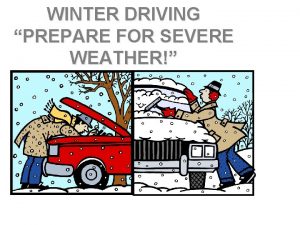Goal for the Day Prepare for farm and






































































- Slides: 70


Goal for the Day Prepare for farm and refinery tours Make the most of the farm and refinery tours -have questions ready* 2

Agenda 8. 30 am Noon 1 pm 2. 30 pm Preparation for Today’s Tour Lunch Farm Tour Ethanol Refinery Tour 3

Introductions NDSU Extension My Position My Work

Economics ‘The study of the allocation of scare resources among alternative ends to satisfy insatiable human wants. ’ 5

Unicorn Fuel There is no perfect fuel, there never will be. There will always be costs, alternatives, choices. Technology, consumer preferences, and resource availability is always changing. 6

Energy Transition Civilization is currently undergoing a major energy transition Rise of renewables and storage Decline of fossil fuels But hasn’t it been doing this since the development of steam power 400 years ago? 7

Dimensions of Sustainability Social (People) Economic (Profit) Environmental (Planet) 8

CORN PRODUCTION 9

So what do you know about modern corn production? 10

11

Corn Advantages C 4 crop Relatively energy dense Storable/transportable Hybrid – naturally protects intellectual property Most well-understood organism on the planet Industries invested in improving production and processing/existing markets for the crop 12

C 4 Plants C 4 plants (eg corn and sugarcane) are very photosynthetically efficient, that is they convert solar energy from the sun into chemical energy than other plants Energy is stored as starch in corn 13

14

North Dakota Corn Shorter growing season and fewer growing degree days than the central corn belt. More recently: New, shorter season varieties Change in climate – wetter, longer, warmer growing seasons Higher prices 15

16

Source: Farmdoc Daily 17

Genetic Potential Seeds are often framed as having genetic potential of achieving certain yields and that less than optimal management and environmental conditions slowly whittle away on it over the growing season. 18

Input Use Efficiency Most corn breeding now looks to reduce losses to stress and take better advantage of resources Nitrogen Use Water Use/Drought Resistance 19

Corn is a resource hog Few other crops have the per acre input requirements of corn – especially when it comes to fertilizer. However, it is very efficient when measured per unit of output. 20

Erosion Conventional tillage and other practices can lead to significant losses of topsoil to wind and water erosion. Can use alternative tillage methods and cover crops. 21

Monocultures Depletes soil of nutrients, which must be replaced Requires weed, pest, and weed control Development of herbicide tolerant “superweeds” There are fields in the Midwest that have been planted to corn every year for decades. 22

Field Operations Field preparation Planting Fertilizer application Weed, insect, disease management Harvest Drying and transportation 23

Production Economics Handout 24

North Dakota Agriculture Handout 25

Jobs Research and development Input sales and marketing Technical assistance/services Production (barriers to entry) Marketing There is tremendous need for more workers, especially skilled workers in agriculture in the next decade. Various levels of education. 26

What questions do you have about corn production? For me? For the family farm we’re going to visit? 27

Break! 28

CORN-ETHANOL REFINING 29

30

Humans have used fermentation for millennia Use of yeast to convert sugars to alcohol Preserving food: sausage, beer, cheese, bread 31

32

Need to break starch down into sugar first An enzyme, alpha amylase, is used to convert starch to sugar (glucose) so it can be fermented. This is typically purchased, but more recently a gm corn variety (Enogen) that produces alpha amylase in the kernel has been released. 33

34

Corn Ethanol Balance A bushel (56 pounds) of corn yields -2. 8 gallons of ethanol (fuel) -17. 5 pounds of distillers grains (animal feed) -1 pound of corn oil (biodiesel production) Some refineries also market CO 2 35

36

Why are margins negative? Demand is weaker than expected -domestically -internationally Corn is expensive -there is fear of a crop shortage due to a wet spring 37

Tharaldson Ethanol Dry Mill 180 million gallons (2 nd largest in the United States? ) Uses 60 million bushels of corn annually, most from within 60 miles of the refinery Gets its water from Fargo 38

ND Ethanol Five refineries 470 million gallon capacity – how much is that? 39

Land Use Change Increased crop and land prices will result in deforestation and other negative environmental impacts. 40

Food vs Fuel There is only so much current and potential cropland. Cropland used for bioenergy production diverts it from food production 41

42

US Corn Ethanol Use>>Feed & Residual

Accounting for ‘Feedback’ Data: WASDE, Grain Crushing and Co-Products Production Report

What questions do you have about ethanol refining? For me? For the tour? 45

Break 46

CLIMATE CHANGE 47

Is climate change a point of contention for you? For your family and friends? For your students? 48

49

50

Unburnable carbon -- fossil fuel energy sources which cannot be burnt if the world is to limit global warming to 2 degrees C. 51

52

Framing as Climate Variation 53

ENVIRONMENTAL LIFE CYCLE ASSESSMENT 54

Remember that GHGs (CO 2) are Pollutants! 55

Environmental Life Cycle Assessment (LCA) Defined • An objective process to evaluate the environmental burdens associated with a product, process, or activity by identifying energy and materials used and wastes released to the environment, and to evaluate and implement opportunities to affect environmental improvements. 56

The Process • Goal and Scope Definition – What are we trying to learn? • Life Cycle Inventory – What’s embedded in the product? • Life Cycle Impact Assessment – What effect does it have? • Data Interpretation – What does it all mean? 57

Corn-ethanol environmental concerns are dominated by GHG emissions 58


Source: EIA Source: USDA 60

Does the use of environmental life cycle assessment impact your thoughts about the ‘greenness’ of ethanol relative to gasoline? 61

Results of life cycle assessments guide regulatory processes in many states and the federal government, for example the US Environmental Protection Agency’s enforcement of the Renewable Fuel Standard and California’s Low Carbon Fuel Standard.

We almost completely ignore social impacts of biofuels. What does it actually mean to farmers, rural communities, workers, consumers. Especially those that are socially disadvantaged. 63

ENERGY BALANCE 64

Definition Net energy = energy delivered-energy used to deliver Energy returned on energy invested (EROEI) = energy delivered/energy used to deliver 65

Hall et al 2014 66

Why the variation? It all depends on model assumptions and the data used. Estimates for corn-ethanol less than 1 usually considered distillers grains waste, as opposed to a co-product 67

There has been a lot of criticism of cornethanol due to its low energy balance. But does it matter if it’s lower cost and more environmentally friendly? How can it be lower cost if it doesn’t have a larger EROEI? 68

Do you have your question(s)? 69

Break and then Lunch! 70
 Day 1 day 2 day 3 day 4
Day 1 day 2 day 3 day 4 Day 1 day 2 day 817
Day 1 day 2 day 817 Difference between partial and complete budgeting
Difference between partial and complete budgeting Peza farm in process
Peza farm in process What was the problem with the farm tools in animal farm
What was the problem with the farm tools in animal farm Who does mollie represent in animal farm
Who does mollie represent in animal farm Doing goal setting on the last day before gspeed freezes
Doing goal setting on the last day before gspeed freezes Beautiful sunday evening
Beautiful sunday evening Prepare and produce cakes and pastries
Prepare and produce cakes and pastries Pgcps calendar a day b day
Pgcps calendar a day b day Oceans apart day after day meaning
Oceans apart day after day meaning Day to day maintenance
Day to day maintenance Physical science chapter 6 review answers
Physical science chapter 6 review answers I don't know about tomorrow
I don't know about tomorrow Growing day by day
Growing day by day Seed germination inhibitors examples
Seed germination inhibitors examples Germination conclusion
Germination conclusion Observation of plant growth day by day
Observation of plant growth day by day I live for jesus day after day
I live for jesus day after day Oh glorious day
Oh glorious day Day one day one noodle ss2
Day one day one noodle ss2 Dayone ss2
Dayone ss2 Hot and cold
Hot and cold Petit fours bases
Petit fours bases Synthesis of chlorobutanol practical
Synthesis of chlorobutanol practical Multimolecular adsorption theory in emulsion
Multimolecular adsorption theory in emulsion How to prepare an income and expenditure account
How to prepare an income and expenditure account What is granules in pharmacy
What is granules in pharmacy Prepare and present sandwiches
Prepare and present sandwiches It is better to prepare and prevent
It is better to prepare and prevent Prepare and serve cocktails
Prepare and serve cocktails Classification of minerals
Classification of minerals Classification of minerals
Classification of minerals Hình ảnh bộ gõ cơ thể búng tay
Hình ảnh bộ gõ cơ thể búng tay Ng-html
Ng-html Bổ thể
Bổ thể Tỉ lệ cơ thể trẻ em
Tỉ lệ cơ thể trẻ em Gấu đi như thế nào
Gấu đi như thế nào Tư thế worm breton
Tư thế worm breton Chúa yêu trần thế alleluia
Chúa yêu trần thế alleluia Môn thể thao bắt đầu bằng từ chạy
Môn thể thao bắt đầu bằng từ chạy Thế nào là hệ số cao nhất
Thế nào là hệ số cao nhất Các châu lục và đại dương trên thế giới
Các châu lục và đại dương trên thế giới Cong thức tính động năng
Cong thức tính động năng Trời xanh đây là của chúng ta thể thơ
Trời xanh đây là của chúng ta thể thơ Cách giải mật thư tọa độ
Cách giải mật thư tọa độ Làm thế nào để 102-1=99
Làm thế nào để 102-1=99 độ dài liên kết
độ dài liên kết Các châu lục và đại dương trên thế giới
Các châu lục và đại dương trên thế giới Thơ thất ngôn tứ tuyệt đường luật
Thơ thất ngôn tứ tuyệt đường luật Quá trình desamine hóa có thể tạo ra
Quá trình desamine hóa có thể tạo ra Một số thể thơ truyền thống
Một số thể thơ truyền thống Bàn tay mà dây bẩn
Bàn tay mà dây bẩn Vẽ hình chiếu vuông góc của vật thể sau
Vẽ hình chiếu vuông góc của vật thể sau Biện pháp chống mỏi cơ
Biện pháp chống mỏi cơ đặc điểm cơ thể của người tối cổ
đặc điểm cơ thể của người tối cổ Thứ tự các dấu thăng giáng ở hóa biểu
Thứ tự các dấu thăng giáng ở hóa biểu Vẽ hình chiếu đứng bằng cạnh của vật thể
Vẽ hình chiếu đứng bằng cạnh của vật thể Vẽ hình chiếu vuông góc của vật thể sau
Vẽ hình chiếu vuông góc của vật thể sau Thẻ vin
Thẻ vin đại từ thay thế
đại từ thay thế điện thế nghỉ
điện thế nghỉ Tư thế ngồi viết
Tư thế ngồi viết Diễn thế sinh thái là
Diễn thế sinh thái là Dot
Dot So nguyen to
So nguyen to Tư thế ngồi viết
Tư thế ngồi viết Lời thề hippocrates
Lời thề hippocrates Thiếu nhi thế giới liên hoan
Thiếu nhi thế giới liên hoan ưu thế lai là gì
ưu thế lai là gì Sự nuôi và dạy con của hươu
Sự nuôi và dạy con của hươu


